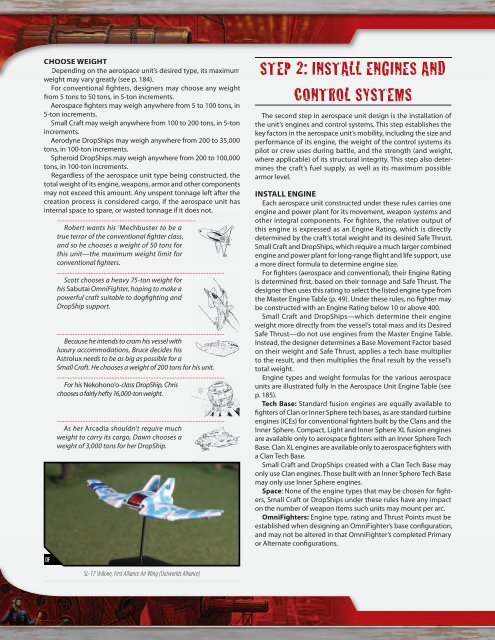the shape of things to come
the shape of things to come
the shape of things to come
Create successful ePaper yourself
Turn your PDF publications into a flip-book with our unique Google optimized e-Paper software.
CHOOSE WEIGHT<br />
Depending on <strong>the</strong> aerospace unit’s desired type, its maximum<br />
weight may vary greatly (see p. 184).<br />
For conventional fi ghters, designers may choose any weight<br />
from 5 <strong>to</strong>ns <strong>to</strong> 50 <strong>to</strong>ns, in 5-<strong>to</strong>n increments.<br />
Aerospace fi ghters may weigh anywhere from 5 <strong>to</strong> 100 <strong>to</strong>ns, in<br />
5-<strong>to</strong>n increments.<br />
Small Craft may weigh anywhere from 100 <strong>to</strong> 200 <strong>to</strong>ns, in 5-<strong>to</strong>n<br />
increments.<br />
Aerodyne DropShips may weigh anywhere from 200 <strong>to</strong> 35,000<br />
<strong>to</strong>ns, in 100-<strong>to</strong>n increments.<br />
Spheroid DropShips may weigh anywhere from 200 <strong>to</strong> 100,000<br />
<strong>to</strong>ns, in 100-<strong>to</strong>n increments.<br />
Regardless <strong>of</strong> <strong>the</strong> aerospace unit type being constructed, <strong>the</strong><br />
<strong>to</strong>tal weight <strong>of</strong> its engine, weapons, armor and o<strong>the</strong>r components<br />
may not exceed this amount. Any unspent <strong>to</strong>nnage left after <strong>the</strong><br />
creation process is considered cargo, if <strong>the</strong> aerospace unit has<br />
internal space <strong>to</strong> spare, or wasted <strong>to</strong>nnage if it does not.<br />
Robert wants his ’Mechbuster <strong>to</strong> be a<br />
true terror <strong>of</strong> <strong>the</strong> conventional fi ghter class,<br />
and so he chooses a weight <strong>of</strong> 50 <strong>to</strong>ns for<br />
this unit—<strong>the</strong> maximum weight limit for<br />
conventional fi ghters.<br />
Scott chooses a heavy 75-<strong>to</strong>n weight for<br />
his Sabutai OmniFighter, hoping <strong>to</strong> make a<br />
powerful craft suitable <strong>to</strong> dogfi ghting and<br />
DropShip support.<br />
Because he intends <strong>to</strong> cram his vessel with<br />
luxury accommodations, Bruce decides his<br />
Astrolux needs <strong>to</strong> be as big as possible for a<br />
Small Craft. He chooses a weight <strong>of</strong> 200 <strong>to</strong>ns for his unit.<br />
For his Nekohono’o-class DropShip, Chris<br />
chooses a fairly hefty 16,000-<strong>to</strong>n weight.<br />
As her Arcadia shouldn’t require much<br />
weight <strong>to</strong> carry its cargo, Dawn chooses a<br />
weight <strong>of</strong> 3,000 <strong>to</strong>ns for her DropShip.<br />
DF DF<br />
SL-17 Shilone, First Alliance Air Wing (Outworlds Alliance)<br />
STEP 2: INSTALL ENGINES AND<br />
CONTROL SYSTEMS<br />
The second step in aerospace unit design is <strong>the</strong> installation <strong>of</strong><br />
<strong>the</strong> unit’s engines and control systems. This step establishes <strong>the</strong><br />
key fac<strong>to</strong>rs in <strong>the</strong> aerospace unit’s mobility, including <strong>the</strong> size and<br />
performance <strong>of</strong> its engine, <strong>the</strong> weight <strong>of</strong> <strong>the</strong> control systems its<br />
pilot or crew uses during battle, and <strong>the</strong> strength (and weight,<br />
where applicable) <strong>of</strong> its structural integrity. This step also determines<br />
<strong>the</strong> craft’s fuel supply, as well as its maximum possible<br />
armor level.<br />
INSTALL ENGINE<br />
Each aerospace unit constructed under <strong>the</strong>se rules carries one<br />
engine and power plant for its movement, weapon systems and<br />
o<strong>the</strong>r integral components. For fi ghters, <strong>the</strong> relative output <strong>of</strong><br />
this engine is expressed as an Engine Rating, which is directly<br />
determined by <strong>the</strong> craft’s <strong>to</strong>tal weight and its desired Safe Thrust.<br />
Small Craft and DropShips, which require a much larger combined<br />
engine and power plant for long-range fl ight and life support, use<br />
a more direct formula <strong>to</strong> determine engine size.<br />
For fi ghters (aerospace and conventional), <strong>the</strong>ir Engine Rating<br />
is determined fi rst, based on <strong>the</strong>ir <strong>to</strong>nnage and Safe Thrust. The<br />
designer <strong>the</strong>n uses this rating <strong>to</strong> select <strong>the</strong> listed engine type from<br />
<strong>the</strong> Master Engine Table (p. 49). Under <strong>the</strong>se rules, no fi ghter may<br />
be constructed with an Engine Rating below 10 or above 400.<br />
Small Craft and DropShips—which determine <strong>the</strong>ir engine<br />
weight more directly from <strong>the</strong> vessel’s <strong>to</strong>tal mass and its Desired<br />
Safe Thrust—do not use engines from <strong>the</strong> Master Engine Table.<br />
Instead, <strong>the</strong> designer determines a Base Movement Fac<strong>to</strong>r based<br />
on <strong>the</strong>ir weight and Safe Thrust, applies a tech base multiplier<br />
<strong>to</strong> <strong>the</strong> result, and <strong>the</strong>n multiplies <strong>the</strong> fi nal result by <strong>the</strong> vessel’s<br />
<strong>to</strong>tal weight.<br />
Engine types and weight formulas for <strong>the</strong> various aerospace<br />
units are illustrated fully in <strong>the</strong> Aerospace Unit Engine Table (see<br />
p. 185).<br />
Tech Base: Standard fusion engines are equally available <strong>to</strong><br />
fi ghters <strong>of</strong> Clan or Inner Sphere tech bases, as are standard turbine<br />
engines (ICEs) for conventional fi ghters built by <strong>the</strong> Clans and <strong>the</strong><br />
Inner Sphere. Compact, Light and Inner Sphere XL fusion engines<br />
are available only <strong>to</strong> aerospace fi ghters with an Inner Sphere Tech<br />
Base. Clan XL engines are available only <strong>to</strong> aerospace fi ghters with<br />
a Clan Tech Base.<br />
Small Craft and DropShips created with a Clan Tech Base may<br />
only use Clan engines. Those built with an Inner Sphere Tech Base<br />
may only use Inner Sphere engines.<br />
Space: None <strong>of</strong> <strong>the</strong> engine types that may be chosen for fi ghters,<br />
Small Craft or DropShips under <strong>the</strong>se rules have any impact<br />
on <strong>the</strong> number <strong>of</strong> weapon items such units may mount per arc.<br />
OmniFighters: Engine type, rating and Thrust Points must be<br />
established when designing an OmniFighter’s base confi guration,<br />
and may not be altered in that OmniFighter’s completed Primary<br />
or Alternate confi gurations.


